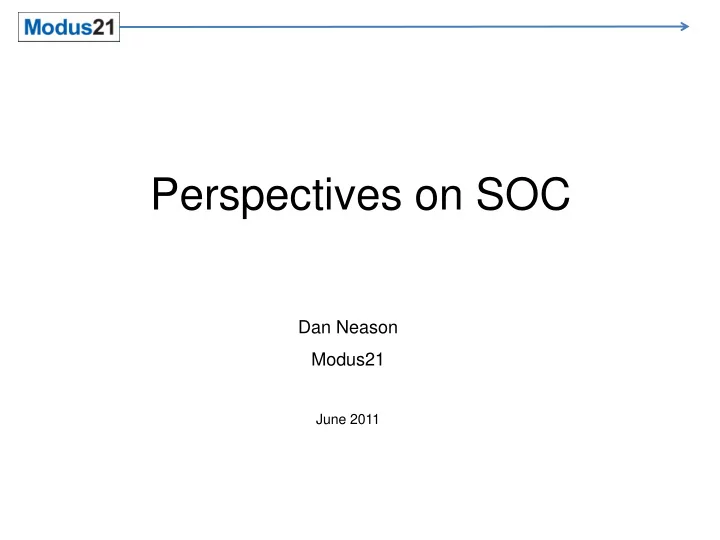

Perspectives on SOC Dan Neason Modus21 June 2011
Frequently Asked Questions • Where are the touch points between software development, process management, and strategic goals? • How do we make our Process Modeling Competency more effective in improvement efforts? • How do SOA and BPM fit together? • With technology and customer expectations changing so fast, how do we adapt?
Presentation Overview • Introduction • Architectural Layering • Traditional vs. Distributed Systems Assumptions • Great Principles of Computing • Importance of Business Architecture • Process Perspectives • Contemporary SOC Platform
Modus21 was founded in 2004 by a group of professionals that believe combining process centric and service oriented design and technology principles provides the basis for superior solutions.
Our delivery methodology has been recognized as ‘unique and effective’ by leading industry analysts. It has been proven in nearly 50 client engagements.
Pace of Change in Society • Layering is natural occurring • Clock of the Long Now presents the idea of societal layers • As described by Peter Morville, “The slow layers provide stability. The fast layers drive innovation.” http://semanticstudios.com/publications/semantics/000003.php
Standards are Layered • Standards define a point of homogeneity amongst vendor products above which vendors build their value-added feature sets to differentiate their products in the marketplace. • Standards work by freezing innovation at one level, allowing more of it at higher levels. • Standardization works from the bottom up, from more basic and broadly-used technologies to more sophisticated and narrowly-used ones.
Layered Standards Web Services Platform Architecture, ISBN-10: 0131488740, pg 34
Architectures are Layered March/April 2007, IT Pro Magazine, “The Role of Solution Architects in Systems Integration”
Changing Systems Assumptions Transaction | Compensation Design | Architecture Creational | Compositional Software Architect Bootcamp, ISBN-10: 0131412272, pg 13
A Study of Contrasts http://semanticstudios.com/publications/semantics/000005.php
Embracing Change Transitioning from… • Traditional/Creational View Application = Data Structures + Algorithms To… • Distributed/Compositional View Application = Computation + Coordination
Great Principles of Computing • Promoted by Prof. Peter Denning, NPS • Article of same title published CACM, 11/2003 • The principles are of two kinds – Mechanics: how computations and computers work – Design: how to build them to work well
5 Windows of Computing Mechanics http://cs.gmu.edu/cne/pjd/GP/gp_summary.html
Primary SOC System Layers • Process – Business Architecture – Coordination + Recollection • BPMS (Business Process Management Suite) • Service – Application Architecture – Computation • SOA (Service-Oriented Architecture) – Standards, Specifications, Principles, Patterns and Practice • Mediation – Infrastructure Architecture – Communication • ESB (Enterprise Service Bus)
Supporting Layers March/April 2007, IT Pro Magazine, “The Role of Solution Architects in Systems Integration”
Supporting Principles • Role of the two principles of Computing Design http://cs.gmu.edu/cne/pjd/GP/gp_summary.html
Commoditization of IT • Happening rapidly via virtualization technologies and cloud computing infrastructure • IT alone does not provide competitive advantage; IT becomes the platform upon which we execute our business processes. • The management science of Business Process Management (BPM) will become the differentiator.
Business Architecture • Business Architecture and design requires us to shift focus to reflect the point of view of the business designers and owners rather than a myopic view on IT solution delivery. • This point of view begins with business motivations, includes key business execution elements – such as operating model, capabilities, value chains, processes, and organizational models – and transcends information technology representations, such as business services, rules, events and information models. • The value of technical solutions needs to be measured in relation to Business Goals and Objectives.
Process Types • All processes are not created equal!
Problem Spaces • Simple = easily knowable. • Complicated = not simple, but still knowable. • Complex = not fully knowable, but reasonably predictable. • Chaotic = neither knowable nor predictable. http://www.noop.nl/2008/08/simple-vs-complicated-vs-complex-vs-chaotic.html
Another Perspective
Solution Spaces
Contemporary SOC Platform Open Source SOA, ISBN-10: 1933988541, pg 16
Summary and Conclusion • Standardization drives innovation and evolution into higher ‘layers’ • Technology has evolved to now require process as a driver – BPM is a key differentiator for success • SOC can be viewed as a system of systems – Each system has primary responsibility for fulfilling the intent of one of the Great Principles of Computing. – It is through this synergistic interaction that the system fulfills its intent of delivering business value. – The whole is greater than the sum of its parts.
Recommend
More recommend